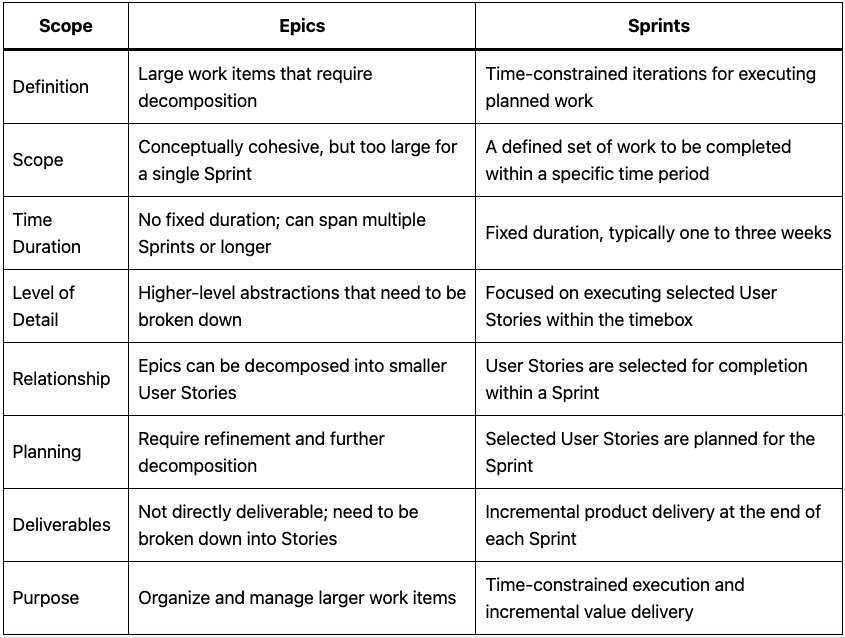Agile methodologies have revolutionized project management by enabling iterative and incremental development. Within Agile, two key concepts play significant roles in organizing and delivering work: Epics and Sprints. While both Epics and Sprints contribute to the overall success of Agile projects, understanding their distinct characteristics and purposes is crucial for effective implementation. In this blog post, we will delve into the world of Epics and Sprints, exploring their definitions, functions, and how they interact within Agile frameworks. By shedding light on their roles, we aim to help teams optimize their work processes, enhance collaboration, and ultimately deliver higher value to customers.
Understanding Epics in Agile
In Agile development, an Epic is a substantial work item that requires further refinement and decomposition into smaller, more manageable User Stories. There are two primary definitions of an Epic. Firstly, an Epic can be perceived as a large User Story that needs to be broken down into smaller, value-adding User Stories that can be delivered independently. Alternatively, an Epic can refer to a collection of related User Stories that share a common objective or theme.
To illustrate this, let’s consider an example. Imagine a development team working on a website. Adding a store to the website would be considered an Epic since it encompasses multiple features such as search, filter, compare, shopping cart, user profile, order tracking, and payment. These individual features are too extensive to be completed within a single Sprint, necessitating further decomposition into smaller User Stories.
The Role of Sprints in Agile
Contrasting Epics, Sprints are timeboxes within the Scrum framework, lasting no more than one month. A Sprint encompasses several events, including Sprint Planning, Sprint Review, Sprint Retrospective, and Daily Scrum, along with effort dedicated to backlog refinement and implementation of work. The primary goal of a Sprint is to deliver a product increment that meets the criteria for delivery or release.
During a Sprint, the Scrum Team commits to accomplishing a planned amount of work. This work is represented by a set of User Stories that align with the Sprint goal and can be feasibly completed within Sprint’s timebox. For instance, a Sprint goal could involve adding a gallery to a website. While this goal may require working on several User Stories, such as setting up a rotating picture gallery, selecting pictures, and adding them, the work remains small enough to fit within a single Sprint.
Difference Between Epics and Sprints in Agile
The distinction between Epics and Sprints lies in their scope, time duration, and level of granularity. Epics, as previously mentioned, represent large, high-level work items that are conceptually cohesive but too extensive to fit into a Sprint. On the other hand, Sprints are time-constrained iterations during which planned work is accomplished to meet the Sprint goal.

To further clarify the dissimilarities, consider the following differentiating characteristics:
- Scope: Epics encapsulate substantial work items that require further decomposition, while Sprints encompass a defined set of work to be accomplished within a specific time period.
- Time Duration: Epics do not have fixed time durations and can span across multiple Sprints or an extended period, whereas Sprints have a predefined duration, usually ranging from one to three weeks, depending on the organization and project context.
- Level of Granularity: Epics are relatively higher-level abstractions that require breaking down into smaller, more manageable User Stories. Conversely, Sprints focus on executing the selected User Stories within the timebox, emphasizing delivering tangible results.
Optimizing Agile Project Management
Effectively managing Epics and Sprints is essential for maximizing productivity, ensuring efficient collaboration, and delivering valuable outcomes in Agile projects. Here are some best practices to consider:
1. Epic Refinement:
Invest time and effort in refining Epics, breaking them down into smaller, well-defined User Stories. This facilitates better estimation, planning, and prioritization, ultimately enhancing the team’s ability to deliver incremental value.
2. Sprint Planning:
Carefully select User Stories for each Sprint based on their feasibility within the timebox. Prioritize work that aligns with the Sprint goal and ensures a coherent increment of the product at the end of the iteration.
3. Continuous Backlog Refinement:
Regularly review and refine the Product Backlog to ensure it accurately reflects the evolving needs and priorities of the project. Keep in mind that Agile projects often involve emergent work, necessitating flexibility and adaptability in adjusting the backlog.
4. Collaboration and Communication:
Foster open and transparent communication among team members, stakeholders, and customers. Effective collaboration ensures shared understanding, and alignment on goals, and promotes the delivery of high-quality solutions.
5. Agile Tooling:
Leverage Agile project management tools, such as JIRA, to support Epics and their associated User Stories. Utilize the capabilities of these tools to visualize Epics, link related User Stories, and track progress across Sprints.
Conclusion
Epics and Sprints play integral roles in Agile project management, facilitating iterative and value-driven development. Epics represent sizable work items that need further decomposition, while Sprints provide time-constrained iterations for executing planned work. By understanding their distinctions and effectively managing their implementation, teams can optimize their Agile processes, enhance collaboration, and deliver higher value to customers.
Successful Agile projects rely on striking a balance between the strategic planning enabled by Epics and the tactical execution facilitated by Sprints. By leveraging the power of both concepts, teams can navigate the complexities of modern software development, adapt to evolving requirements, and deliver solutions that meet the dynamic needs of customers in a rapidly changing marketplace.



